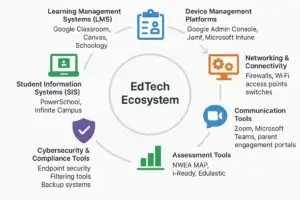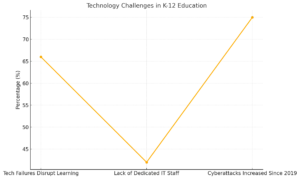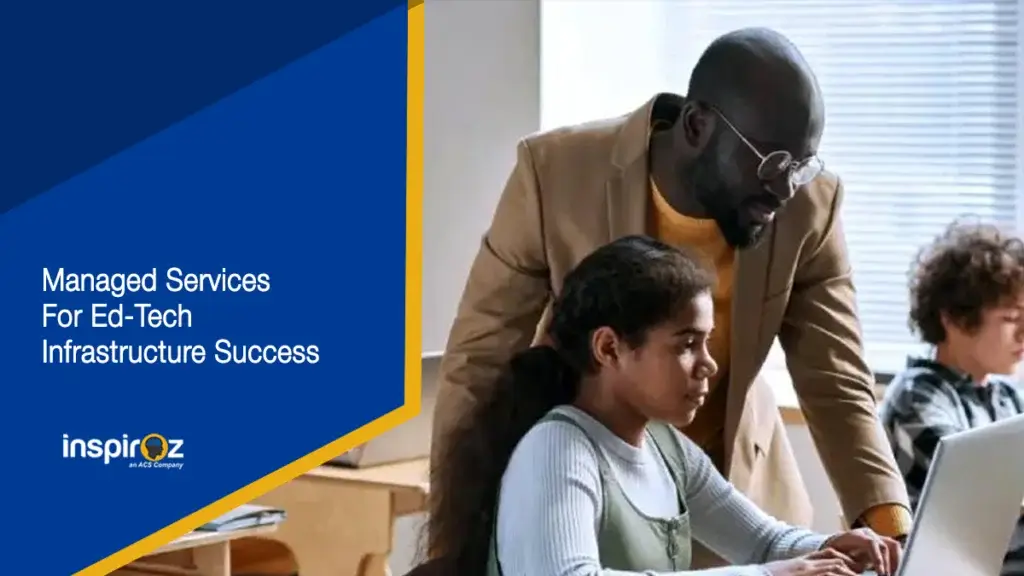From Learning Management Systems (LMS) to digital classrooms, the success of any charter school or EdTech-enabled environment depends heavily on having the right tech stack in place.
But technology alone isn’t enough. To keep it secure, scalable, and functioning seamlessly, many schools are now turning to managed IT services.
What is a Tech Stack in the EdTech World?
A tech stack is a combination of software, hardware, and cloud-based tools that work together to deliver educational content, manage operations, and support student and staff productivity. In a charter school or any modern K-12 institution, this might include:
- Learning Management Systems (LMS) – Google Classroom, Canvas, Schoology
- Student Information Systems (SIS) – PowerSchool, Infinite Campus
- Device Management Platforms – Google Admin Console, Jamf, Microsoft Intune
- Networking & Connectivity – Firewalls, Wi-Fi access points, switches
- Communication Tools – Zoom, Microsoft Teams, parent engagement portals
- Assessment Tools – NWEA MAP, i-Ready, Edulastic
- Cybersecurity & Compliance Tools – Endpoint security, filtering tools, backup systems

Managing all these components—and ensuring they work well together—is no small feat, especially for schools with limited in-house IT teams. That’s where managed services come into play.
Why EdTech Infrastructure Need Support?
Here’s a scenario: A school rolls out 1:1 Chromebooks for students, integrates a new LMS, and implements cloud-based grading tools. But within weeks, teachers report login issues, students struggle with connectivity, and the IT lead—who also teaches math—is stretched thin.
Technology in schools must work reliably. When it doesn’t, it affects not only academic performance but also equity, safety, and morale.
A 2022 EdWeek Research Center survey found that:
- 66% of educators said tech failures caused frequent disruptions in learning.
- 42% of schools lacked dedicated IT staff to manage daily tech issues.
- Cyberattacks on K-12 institutions have increased by over 75% since 2019.

These numbers point to a clear need for reliable, proactive support. Managed services ensure that schools not only deploy EdTech effectively but sustain its performance over time.
The Role of Managed Services in Each Layer of the Tech Stack
Let’s break down how managed services can support different components of the school tech stack:
1. Devices & Hardware Management
Most charter schools now use Chromebooks, iPads, or laptops for student learning. Managing hundreds of devices requires:
- Inventory tracking
- Remote updates
- Break/fix support
- Device security
Managed services can streamline this by offering:
- Centralized dashboard access for admins
- Scheduled maintenance and patch management
- Helpdesk support for hardware issues
- Warranty coordination and repair programs
Some providers even offer Chromebook repair services to ensure cost control.
2. Networking and Internet Infrastructure
- High-speed, secure internet is non-negotiable in a digital classroom. MSPs ensure:
- Reliable Wi-Fi coverage across campuses
- Firewall and content filtering setup
- VLAN segmentation for guest/staff/student networks
- 24/7 monitoring to detect outages or threats
Many managed providers include E-rate expertise to help schools optimize bandwidth and funding.
3. Cloud-Based Applications (LMS, SIS, Collaboration Tools)
- Software as a Service (SaaS) tools require:
- Integration with school directories
- Single Sign-On (SSO) setup
- Permissions management
- Data backups
Managed services ensure these platforms are:
- Integrated properly with student and teacher rosters
- Updated regularly without disrupting use
- Secure, with appropriate user access controls
- Backed up, in case of accidental data loss
This ensures teachers spend less time troubleshooting and more time teaching.
4. Cybersecurity & Compliance
Cybersecurity is a growing concern in K–12 education, particularly for charter schools that manage sensitive student and staff data but often lack the resources of larger districts.
Managed services can significantly strengthen a school’s security posture by:
- Setting up firewalls, antivirus, and endpoint protection
- Monitoring networks for suspicious activity or breaches
- Implementing multi-factor authentication (MFA) for critical systems
- Conducting phishing simulations and security awareness training
- Ensuring compliance with FERPA, COPPA, and HIPAA regulations
Inspiroz, for instance, provides cybersecurity services tailored for charter schools, helping schools stay ahead of threats with layered defense strategies and compliance audits.
5. Backup & Disaster Recovery
Data loss, whether from natural disasters, human error, or ransomware attacks, can cripple school operations. A proper backup and disaster recovery plan is essential.
- A managed services provider can help schools:
- Automate daily cloud backups
- Store backup data off-site or in secure cloud environments
- Run disaster recovery drills to ensure system restoration readiness
- Develop business continuity plans aligned with academic calendars
With Inspiroz’s data backup and disaster recovery solutions, schools can recover quickly with minimal disruption, ensuring students don’t miss out on learning time.
Real-World Benefits: Why It Matters
Here’s what charter schools typically gain by adopting a managed services model:
| Benefit | Impact on Schools |
| Proactive IT Monitoring | Downtime is minimized, reducing disruptions during instructional hours |
| Predictable Costs | Flat-rate IT support helps budget planning and reduces emergency costs |
| Better Staff Productivity | Teachers and admin focus on students, not tech issues |
| Security Peace of Mind | Threats are monitored and mitigated before they cause damage |
| Future-Ready Tech Planning | MSPs help schools scale as enrollment and digital needs grow |
Common Concerns (And Why They’re Misunderstood)
❌ “We don’t need help. We already have an IT person.”
✅ One internal IT staffer can’t monitor networks 24/7, resolve hundreds of tickets, manage updates, and lead strategic planning. Managed services augment your team—not replace them.
❌ “It’ll be expensive.”
✅ Think about the cost of downtime, ransomware recovery, or lost productivity. Managed IT support often costs less annually than one full-time hire and covers far more.
❌ “We’ll lose control of our tech.”
✅ A reputable provider like Inspiroz works with your team, ensuring transparency, shared documentation, and real-time reporting dashboards.
Building the Right Foundation for Long-Term Success
When charter schools and EdTech institutions invest in modern technology, they are committing to a vision of accessible, engaging, and scalable education. But that vision can only succeed if the infrastructure behind it is:
- Reliable
- Secure
- Well-managed
- Built to scale
Managed services are the connective tissue that makes your tech stack resilient and functional. They take the burden off overworked staff, reduce risk, and create a foundation that allows innovation to thrive.
Whether your school is implementing its first LMS, planning a 1:1 device rollout, or dealing with recurring IT issues, now is the time to assess your tech infrastructure—and explore how managed services can help.




